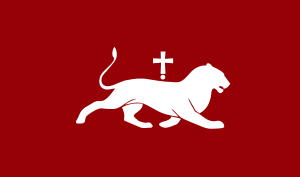Bagratuni dynasty
| Bagratuni | |
|---|---|
 | |
| Parent house | Orontid Dynasty |
| Country |
Armenia Caucasian Albania |
| Ethnicity | Armenian |
| Founded | 100 BC |
| Founder | Ashot I |
| Final ruler | Gagik II |
| Titles | |
| Cadet branches |
Rubenids (possibly) Hasan-Jalalyan (indirectly) |
The Bagratuni or Bagratid (Armenian: Բագրատունի, Armenian pronunciation: [bagɾatuni]) royal family ruled many regional polities of the medieval Kingdom of Armenia, such as Syunik, Lori, Vaspurakan, Vanand, Taron, and Tayk.[1]
Early history
The Bagratid family first emerged as nakharars, members of the hereditary nobility of Armenia. Their holdings were in the region of İspir, in the Çoruh River valley. As early as 288–301, the Bagratid prince Smbat held the hereditary Armenian titles of Aspet, which means Master of the Horse, and T'agatir, which means Coronant of the King.[2]
According to Prince Cyril Toumanoff, the earliest Bagratid prince was chronicled as early as 314 AD. In the 8th century, Smbat VII Bagratuni revolted against the Abbasid Caliphate but the revolt was defeated.
Bagratids in Armenia
The Bagratid Princes of Armenia are known as early as 1st century BC when they served under the Artaxiad Dynasty. Unlike most noble families of Armenia they held only strips of land, as opposed to the Mamikonians, who held a unified land territory. These are the earliest Bagratid princes in Armenia prior to the establishment of the kingdom, as mentioned by the Union of Armenian Noblemen. Ashot I was the first Bagratid King, the founder of the Royal Bagratid dynasty. He was recognized as prince of princes by the court at Baghdad in 861, which provoked war with local Arab emirs. Ashot won the war, and was recognized as King of the Armenians by Baghdad in 885. Recognition from Constantinople followed in 886. In an effort to unify the Armenian nation under one flag, the Bagratids subjugated other Armenian noble families through conquests and fragile marriage alliances. Eventually, some noble families such as the Artsrunis and the Siunis broke off from the central Bagratid authority.[3] Ashot III the Merciful transferred their capital to the city of Ani, now famous for its ruins. They kept power by playing off the competition between the Byzantine Empire and the Arabs.
They assumed the Persian title of "King of Kings" (Shahanshah).[4] However, with the start of the 10th century and on, the Bagratunis broke up into different branches, breaking up the unified kingdom in a time when unity was needed in the face of Seljuk and Byzantine pressure. The rule of the Ani branch ended in 1045 with the conquest of Ani by the Byzantines.
The Kars branch held on until 1064. The dynasty of Cilician Armenia is believed to be a branch of the Bagratids, later took the throne of an Armenian Kingdom in Cilicia. The founder, Ruben I, had an unknown relationship to the exiled king Gagik II. He was either a younger family member or kinsman. Ashot, son of Hovhannes (son of Gagik II), was later governor of Ani under the Shaddadid dynasty.
 The Walls of Ani
The Walls of Ani Taraz (national costume) of an Armenian woman during Bagratid dynasty
Taraz (national costume) of an Armenian woman during Bagratid dynasty
See also
References
- ↑ http://rbedrosian.com/Ref/CMH1.htm
- ↑ Movses Khorenatsi. History of the Armenians. Translation and Commentary of the Literary Sources by R. W. Thomson. Cambridge, Massachusetts: Harvard University Press, 1978 Appendix A. Primary History, pp. 358-359, 362, 365-366
- ↑ Herzig, Kurkichayan, Edmund, Marina (2005). The Armenians: Past and Present in the Making of National Identity. Routledge. p. 43.
- ↑ Tim Greenwood, Emergence of the Bagratuni Kingdoms, p. 52, in Armenian Kars and Ani, Richard Hovannisian, ed.
- "Sebeos' History"
- John Mamikonean's History of Taron"
- "Aristakes Lastivertc'i's History "
- "Kirakos Gandzakets'i's History of the Armenians"
- Vahan Kurkjian - The Bagratid Dynasty — The Bagratuni
Genealogy
- Prince Cyrille Toumanoff, Manuel de généalogie et de chronologie pour l'histoire de la Caucasie Chrétienne (Arménie-Géorgie-Albanie). Edizioni Aquila, Roma, 1976. - still remains the only account of the family generally available in the West, although its scientific standard has been criticized as very low.
- The Families of the Nobility of the Russian Empire, Volume III, Moscow, 1996. - contains the latest research available in Russian, compiled by Georgian scientists, some of them Bagratids themselves.
- Armenian Nobility Site
- Robert Bedrosian's History Page
History
- R. H. Hewsen. "Armenia: A Historical Atlas", 2001 ISBN 0-226-33228-4
External links
![]()

